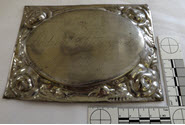Plate, Coffin
| Nom de l'objet : | Plate, Coffin |
| Catégorie de l'objet : | Funerary object |
| Matériaux : | tin |
| Numéro d'accession : | 1967.09.01 |
| Date de fin de production : | 1967-12-31 |
| Description : | The object is a silver tin coffin plate that is rectangular in shape with an embossed oval in the centre. The outer corners have embossed roses and leaves. |
| Fonctions : | Coffin plates are decorative additions to coffins that usually contain information such as the name and death date of the deceased. They are generally made of metal such as lead, pewter, silver, brass, copper, zinc, or tin. For a basic funeral, a simple lead plate with the name, date of death and age of the deceased engraved on it would be nailed to the lid of a wooden coffin. Those who could afford more than a simple coffin plate would use a more expensive metal and the plate itself would be more elaborate in design. Coffin plates are thought to have been used since the 17th century and were originally used for people of stature. Once the industrial revolution began, the price of the plates went down so much that by the 19th century, almost anyone wishing for a coffin plate could afford one. Wealthy people could commission a metalworker to craft more elaborate coffin plates that were considered works of art. At the other end of the spectrum, many plates were made by a local blacksmith or tinsmith and were simple in design. In the 1840s, machine made coffin plates began to appear. A first, they were simple shapes made from one piece of metal. By the 1860s, more elaborate shapes began to appear and there were dozens of shapes to choose from as well as several manufacturers. The industrial coffin plates were blank, as they were intended for a local metalworker to finish the final engraving. Around the 1860s as well, the practice began of removing coffin plates before burial began. Often, the coffin plate was set up on a table next to the actual coffin. The plates were often removed to be a memento of the deceased. This practice was popular in the northeastern United States from the 1840s to the 1920s. |
| Longueur : | 12.07 cm |
| Largeur : | 9.07 cm |
| Établissement : |
Shelburne County Museum
 Facebook-Shelburne County Museum Facebook-Shelburne County Museum
|
| Ville de l'établissement : | Shelburne |
| Province de l'établissement : | Nova Scotia |
Coordonnées de cette page web
-
Pour proposer des corrections ou des mises à jour sur cette page, veuillez contacter directement le Réseau canadien d’information sur le patrimoine (RCIP).

